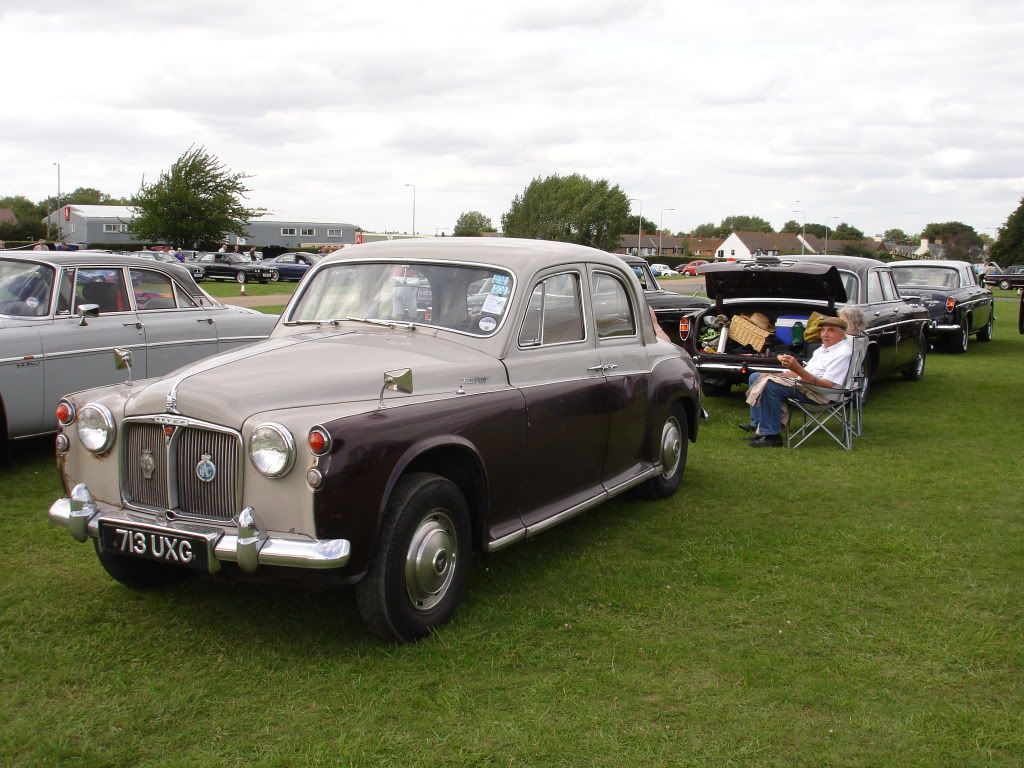Deleted
Deleted Member
Posts: 0
|
Post by Deleted on Feb 19, 2010 22:54:06 GMT
|
|
|
|
Post by Smallfry on Feb 20, 2010 0:20:49 GMT
It is a sub type of Rover P4. Dont know that much about them myself, other than its the last incarnation of the model (I think) I dont know what the "110" actually signifys, but no doubt someone on here will know.
|
|
|
|
Post by Warwick on Feb 20, 2010 1:45:24 GMT
Weren't all Rover model designations rated horsepower up until they switched to useing engine capacity to identify them?
|
|
|
|
Post by glennr on Feb 20, 2010 7:51:21 GMT
They come in a variety of types i.e Rover 80, 90, 95, 100 and 110 which just designates their top speed.
They enlarged the engine to 2,286, 2,625 and 2,639cc and reduced it to four cylinders of 1,997 and 2,286cc, offering power outputs of 60, 80, 90, 100, 102, 105, 110, 115 and 123bhp. They tinkered with the brakes, the suspension and the gears; the steering-column gear lever of the original 75 was replaced by a long, dog-legged and whippy lever pivoted on an exposed ball-joint on the transmission tunnel; the delectable free-wheel that had made changing gears in the reluctant box so much easier and clutchless, was replaced by overdrive, and, conceding to the demand for automatic gears, they devised the ghastly semi-automatic Roverdrive system.
The P4 gathered weight, bulk and resistance; in its most powerful incarnation, its 115bhp engine with twin carburettors could propel it to 100mph, but its petrol consumption averaged 18mpg. By the time the Rover 3-litre appeared in 1959, the P4 looked staid, dull and antique.
The Rover 110 was produced from 1962 to 1964, during this period 1534 cars were built. The model replaced the Rover 100 and incorporated the following basic differences:
The engine was increased in power by the introduction of the "Weslake" head and larger bore carburettor initially developed to increase performance of the Rover 3 litre (P5). Power was 123 bhp giving a top speed in excess of 100 mph. Fuel consumption was 18 - 23 mpg.
Many other 3 litre components were also used, for example the instruments and wheel discs. Initially the doors of the 110 were manufactured in aluminium alloy but were changed early in the production run to steel.
Overdrive on top gear was standard but to avoid overstressing, which was possible with the increased performance, the kick down facilty was removed. The car is the most relaxed high speed cruiser of the P4 range and today can keep up a good pace in modern traffic except on winding roads where the handling is not up to modern standards due in part to the 60/40 front to rear weight distribution.
sourced
|
|
|
|
Post by Phil Nottingham on Feb 20, 2010 10:33:33 GMT
Good precis Glenn - having P4 Rover 100 I am biased though. The numbers originally referred to approx BHP though, apart from in the 95 and 110 where they wanted more differentiation from the Mk2 3 Litres which were the top of the Rover range as 120 implied more power than P4 owners may have wanted P5's actually used P4 components until the 100 used a short stroke 2.6 litre veriosn of the new 3 litre 7 bearingIOE 6 engine developed from the engine first used in a P3 Both shared the new instruments and seats used in the Mk2 3 litres and the 110 also had the Westlake head designed for the Mk2 3 litres but with a special short inlet manifold. The 95 continued the old detuned 100 engine with combined head/manifold which later went into some LWB Land RTovers till 1980 when it was replaced by the P5B V8 The 1958 Rover 75 was the last Rover (and British car) to use a Freewheel which first appeared in the 1930's Rovers (I have one in my P2). This allows clutchless gearchanges when moving but there is no engine braking so good brakes are essential  The P4 80 used the new OHV 4 cylinder engine developed for petrol Land Rovers in 1958 which also formed much of the new Deisel engine for them too cgi.ebay.co.uk/classic-rover-100-p4_W0QQitemZ280466555575QQcmdZViewItemQQptZAutomobiles_UK?hash=item414d1c02b7The interior in the picture is not the same car! The P6 replaced the P4 although both were made at the same time for 1963/64   |
|
theroveringmember
Rover Fanatic
   P5B Saloon - P4 110 - P6B x2 - 2200TC - 2000TC (S1) 2000SC........How Many Is Too Many?
P5B Saloon - P4 110 - P6B x2 - 2200TC - 2000TC (S1) 2000SC........How Many Is Too Many?
Posts: 446
|
Post by theroveringmember on Feb 20, 2010 13:03:01 GMT
This is our early, alloy door 110 (though one rear is steel) at last years P5 National, she's currently a daily runabout. Our P5B too with the open boot. Not to mention my Father. Your script badge is from the bonnet side.  |
|
|
|
Post by Phil Nottingham on Feb 20, 2010 14:38:22 GMT
In somewhat beeter condition than the Ebay one!
|
|
Deleted
Deleted Member
Posts: 0
|
Post by Deleted on Feb 20, 2010 18:05:37 GMT
TRM,
Lovely photo! Where was it taken?
|
|
theroveringmember
Rover Fanatic
   P5B Saloon - P4 110 - P6B x2 - 2200TC - 2000TC (S1) 2000SC........How Many Is Too Many?
P5B Saloon - P4 110 - P6B x2 - 2200TC - 2000TC (S1) 2000SC........How Many Is Too Many?
Posts: 446
|
Post by theroveringmember on Feb 20, 2010 20:05:19 GMT
The Imperial War Museum at Duxford, the WW2 fighter aerodrome & home of Douglas Bader's famous "Duxford wing". en.wikipedia.org/wiki/Big_WingAuntie scrubs up well but does need some TLC when I can manage to relieve her of daily duties for a while. |
|